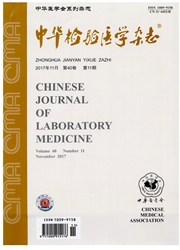

 中文摘要:
中文摘要:
目的建立检测患者血清中HBV的x抗原(HBxAg)及其抗体(anti-HBx)的方法,阐明其在慢性肝炎、肝硬化和肝癌患者血清中的临床意义。方法将HBV的x基因全长克隆至原核表达载体pET30a(+)中,构建pET30a-X原核表达载体,转化人大肠杆菌BL21(DE3)后,经异丙基-β-D-硫代半乳糖苷(IPTG)诱导表达His-HBx融合蛋白,纯化后将重组蛋白免疫家兔,制备兔抗HBx多克隆抗体。应用纯化后的兔抗HBx多克隆抗体和纯化后的重组蛋白,建立检测血清中HBxAg和anti-HBx的方法。应用建立的ELISA法,分别对慢性乙型肝炎、肝硬化和肝癌患者组及正常对照组血清中HBxAg和anti-HBx进行检测。结果HBxAg/anti-HBx在慢性乙型肝炎、肝硬化和肝癌患者中的阳性率分别为8.7%/10.4%,17.9%/40.6%,9.8%/34.4%。统计学分析显示,与慢性乙型肝炎相比,肝硬化或肝癌患者血清中anti—HBx的阳性率较高(P〈0.01)。结合临床检测的其他HBV血清学指标,发现在anti-HBs阳性病例中,anti-HBx阳性率为5.2%(1/19);而在HBsAg、HBeAg和anti-HBc3项同时为阳性的病例中,anti-HBx的阳性率为28.9%(39/135),二者相比,差异具有统计学意义(P〈0.05)。213名正常对照血清中HBxAg和anti-HBx均为阴性。结论血清中anti-HBx并非一个保护性抗体,标志HBV的感染和复制,是从慢性乙型肝炎向肝硬化和(或)肝癌发展的血清标志之一。
 英文摘要:
英文摘要:
Objective To establish a method of detecting hepatitis B virus x antigen (HBxAg) and antibody to HBxAg (anti-HBx) and to demonstrate its clinical significance of HBxAg and anti-HBx in sera from patients of chronic hepatitis B ( CHB), liver cirrhosis ( LC ) and hepatocellular carcinoma (HCC). Methods Full length HBx gene was cloned into pET30a ( + ), a prokaryotic expression vector, named pET30a-X. It was transformed into Escherichia coli BL21 ( DE3 ) , followed the fusion protein of HBx-His was induced by IPTG. The purified fusion protein was used to immunize rabbit as an antigen to generate polyclonal antibody to HBx protein. The method of enzyme-linked immunosorbent assay (ELISA) was established by using purified fusion protein and generated antibody, which was used to detect HBxAg and anti-HBx in sera from patients of CHB, LC, HCC and normal healthy people. Results The positive rates of HBxAg/anti-HBx were 8.7%/10.4% for CHB, 17.9%/40.6% for LC, and 9.8%/34.4% for HCC, respectively. In statistics, the positive rates of anti-HBx in LC and HCC were higher than that in CHB (P 〈 0. 01 ). With the data from clinical examination of HBV markers in sera, it was found that the positive rate of anti-HBx was 5.2% ( 1/19 ) in anti-HBs + cases, however, the positive rate of anti-HBx was 28.9% (39/ 135) in HBsAg +/HBeAg +/anti-HBc + cases. The two positive rates were significant difference (P 〈 0.05 ). Both HBxAg and anti-HBx were totally negative in the sera from normal healthy people (n =213) as negative control. Conclusions Anti-HBx in sera is not a protective antibody, showing infective and replication of HBV. The positive of anti-HBx in sera demonstrates the development from CHB to LC and HCC.
 同期刊论文项目
同期刊论文项目
 同项目期刊论文
同项目期刊论文
 期刊信息
期刊信息
